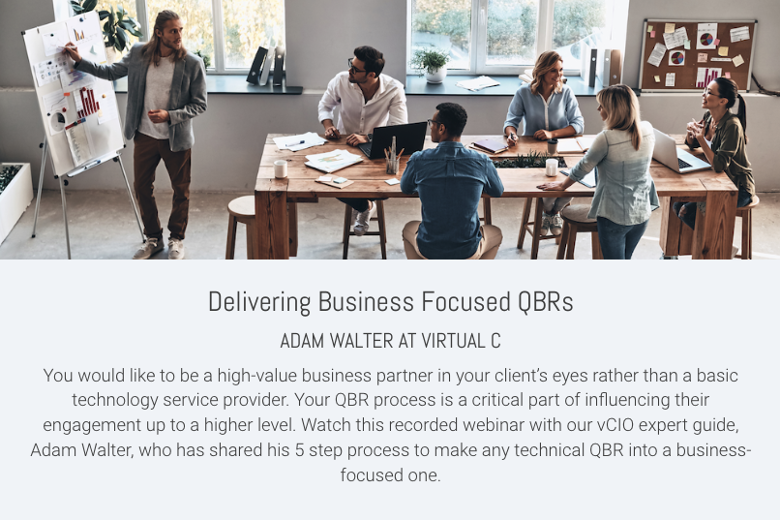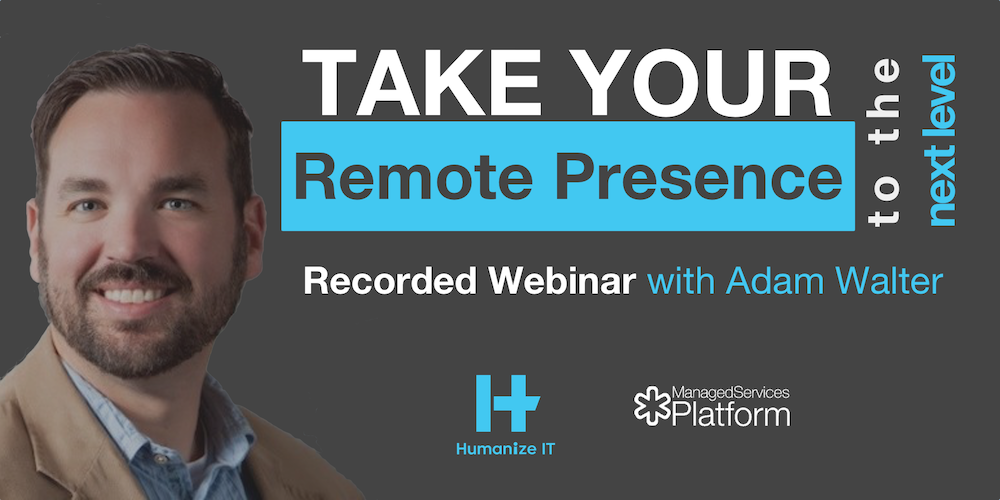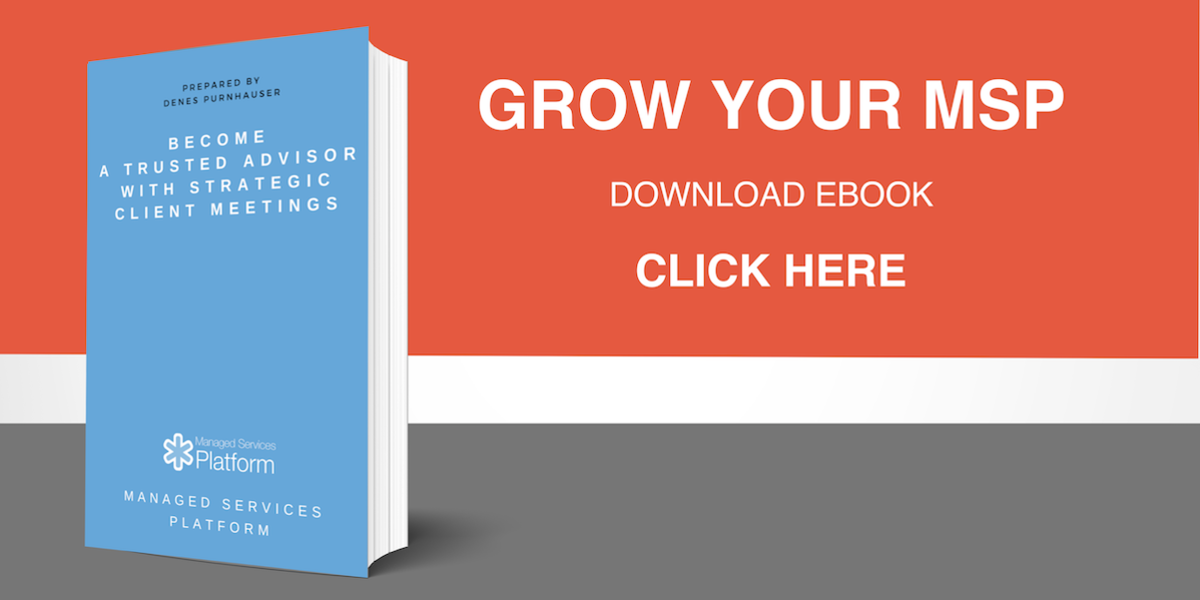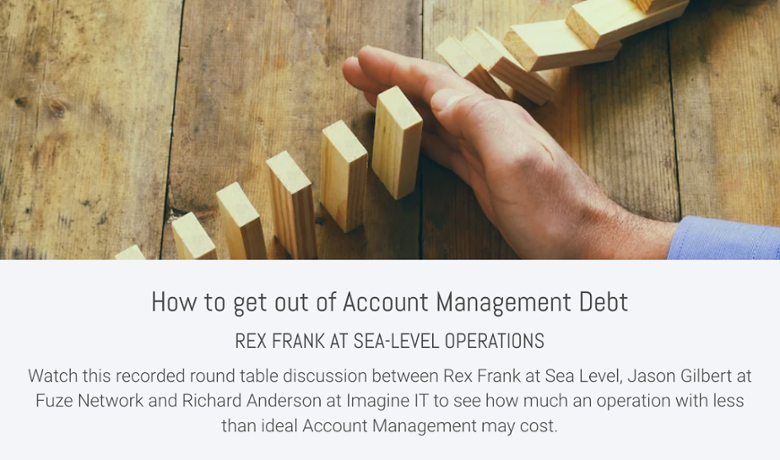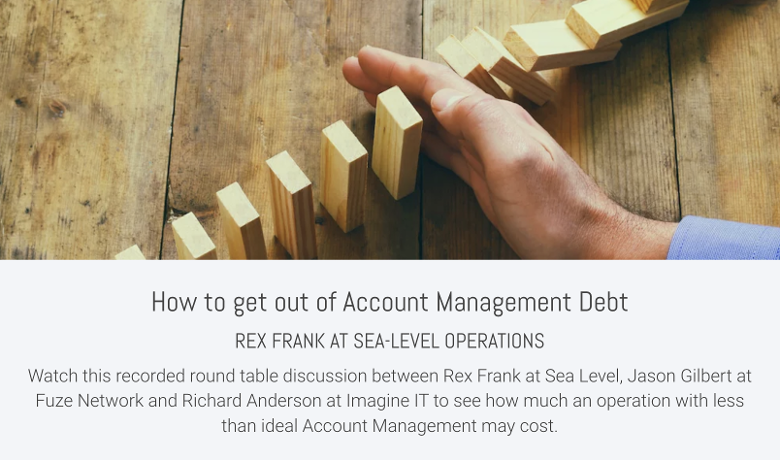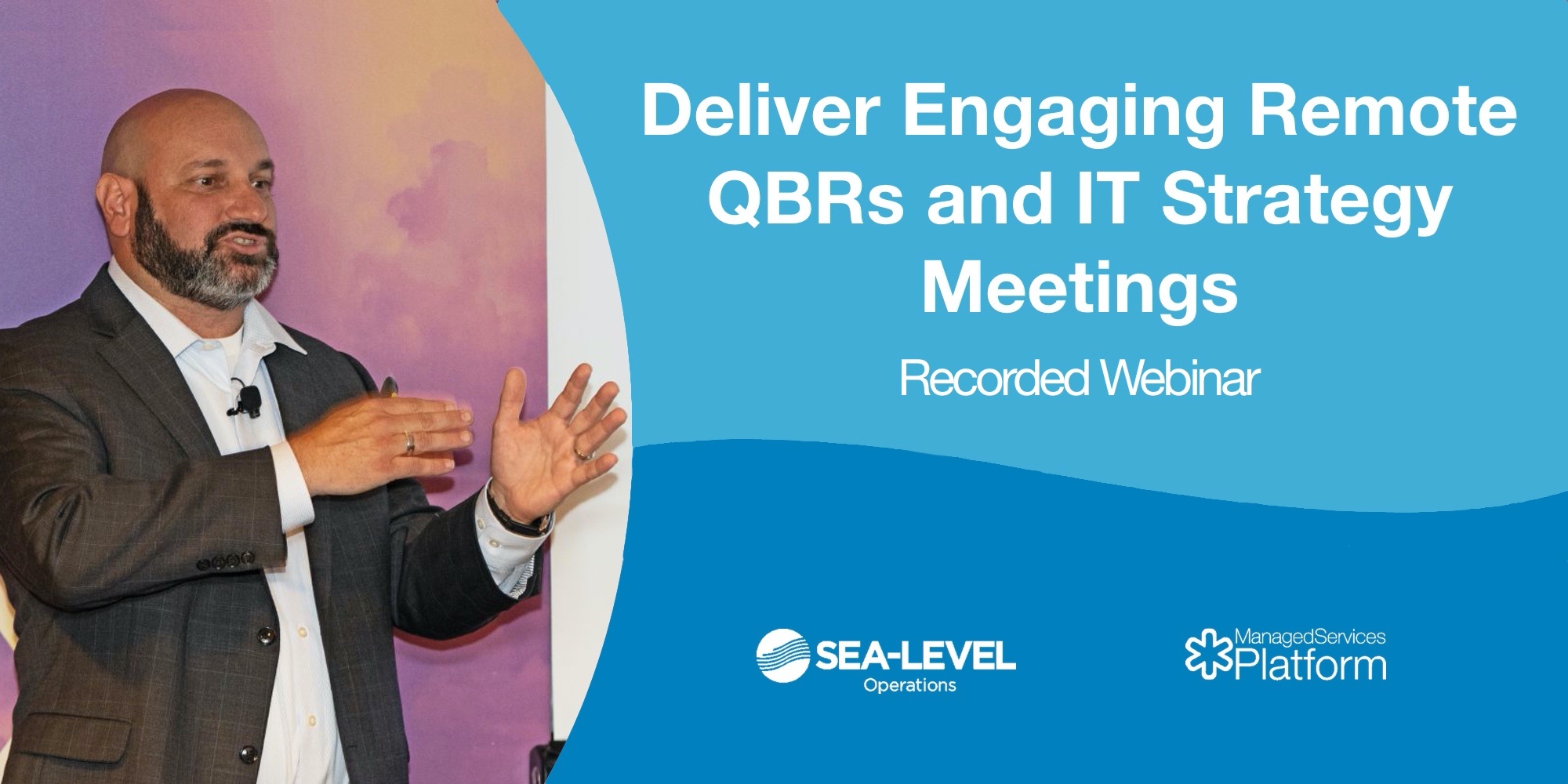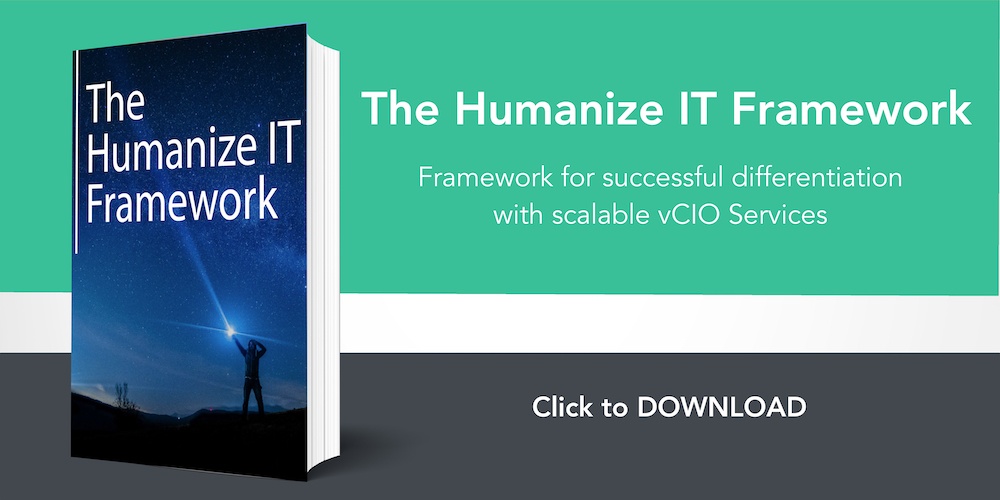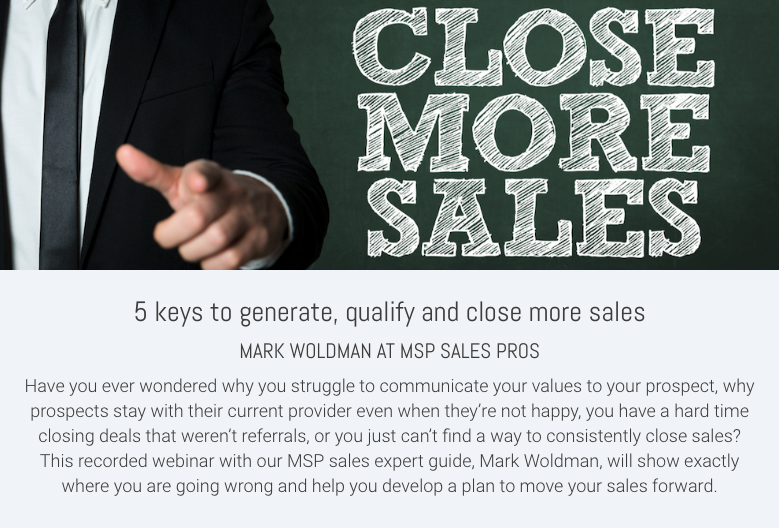Why your QBRs are costing you, customers
By Adam Walter on September 2 2019
-2.jpg)
For those of us who have been in technology for a while, we have seen some pretty crazy setups from well-meaning people. Largely this is because we have very smart capable people trying to work in environments with limited knowledge. Most were trying their hardest but just didn’t know any better.
Some of the crazy things I saw back in the day were “vlans” that were actually just subnets, firewalls with giant holes in the ruleset, and unrestricted VPNs that were completely insecure. These mistakes were not made by lazy admins, they were made by well-intentioned technicians that didn’t know they were doing anything wrong. All they knew was that things were working smoothly.
But how do we know when we are doing something incorrectly?
This is how it works in the technical industry, new items come out so often that we do our best to learn what we can. Most of us will reach out when something isn't working. Google is always there. We can also hire a consultant who specializes to review our work and can show us the ropes. But how do we know when we are doing something incorrectly? After all ‘Any-Any’ firewall rules will get the job done right?
The same problem exists within vCIO programs and QBR delivery. How would you know if you are doing them wrong? Are you assuming things are going well just because your client is present and getting details? If this is the case then it is very much like putting an Any-Any firewall rule in place. Sure it will work, but what happens when your client experiences the right way?
There is definitely a ‘right’ way to deliver a vCIO program and definitely a ‘right’ way to deliver business-focused QBRs. We have many stories of MSPs who lose customers when the customer sees a better way and realizes what they have been missing.
The best way I can think to help you identify whether or not you are running quality QBRs is to compare and contrast a tactical vs a business-focused QBR. Tactical QBRs are very useful when talking to technical professionals, business QBRs are best suited for talking to...yes you guessed it...business professionals. Let's take a look at a QBR delivery by a vCIO. The first situation will focus on a tactical delivery and the other will focus on the business.
Tactical QBR:
MSP R Us comes in to deliver a review of their activities for the quarter. They do a fantastic job of showing the customer how many tickets were processed and give them progress reports on the firewall upgrade. There is even a review of the new features the firewall offers. The customer is happy with the progress on the upgrade and they can see that tickets are being handled in an appropriate amount of time.
Business-focused QBR
MSP R Us comes in to deliver their review of activities for the quarter. However, they do not talk about tickets or the firewall upgrade. Instead, they talk through how the business is doing and review major business objectives from the previous quarter. It is brought up that last quarter the training team was having issues sharing videos with clients and hosting webcasts so a firewall project was started to stabilize the connection. The conversation centers around how things are going with the training team and if they are meeting their goals now. It turns out the upgrade has helped significantly.
They have noticed though that while the streaming has stabilized, they are not getting high resolution and would like to know if someone could help them out. The vCIO notes the request for the coming quarter as a project and will open a ticket.
The conversation continues with any other areas of business that need to be addressed in the next quarter. The client states that they have an big product release coming up and are feeling anxious. The vCIO also notes this and creates a change freeze during that time to ensure that disruptions to workflow are minimal.
Review
In either situation, nothing was done “wrong” persay but you can see the business-focused QBR was much more fluid and quite a bit more information was gathered about how to help the client.
Most MSPs will run tactical QBRs because it is familiar and sticks to their wheelhouse. However, they are missing out on a big piece of customer experience. They are also missing out on valuable insights as to upcoming projects and whether or not project delivery is meeting business goals.
The question is, how do you get your QBRs to be less tactical and more business-focused? The good news is, with focus and hard work you can build this. The bad news is that just like learning appropriate firewall design it is a bit of a process. You need a few pieces:
- An annual framework for delivery where you have created a relationship with your client.
- A continuous feedback loop for business objectives.
- Give your staff the confidence to lead non-technical conversations.
You can create this process with hard work, or you can also hire a consulting/coaching agency to come in and develop the process and employees.
The one thing we know is that if you do not start delivering business-focused QBRs someone else will. So the real question you need to ask is:
Do you want to be the MSP clients switch FROM,
or do you want to be the MSP clients switch TO?
The 4 roles that make you a high value business partner
By Denes Purnhauser on August 30 2019
Transforming your Basic IT Service Provider company into a high-value business partner is a study in communication - why you communicate, what you communicate and who is communicating to whom. There are four roles that are critical to your relationship with your clients. The communication from these four critical roles will determine whether your company is becoming a commodity or a differentiated brand. Let’s take a look at these roles and what you can do to make sure their communication will be excellent.
Client Engagement Roles
Client Engagement Roles are responsible for interaction and involvement with your clients in various distinct business activities, and are defined by their area of focus. As very few MSPs have yet to clearly delineate those roles, a lack of clarity creates unnecessary noise within the process of client engagement.
Your client engagement roles should be separated by the nature of the activities (Business or Technology Related) and by the focus of the activities (Tactical or Strategic).
We have four different roles segmented by nature and focus of activities. Account Managers and Technical Account Manager roles are responsible for the tactical focus and Business vCIOs and Technical vCIOs are responsible for the Strategic focus.
The reasons for doing this:
- the client audience will be distinct (CEO / CFO / Office Manager / IT Coordinator)
- the required skills of the various activities will be distinct (Sales, Planning, Strategy, Technical)
- the engagement cycles will be variable (Strategic - Annual and Tactical - Quarterly)
Without proper separation of the roles, client engagement will be inefficient and your communication will be confusing.
Examples:
- the owner of the client entity has to sit in a meeting discussing tickets and backup issues quarterly
- the account manager is asking approval for a project from an office manager
- clients are not interested in participating in business review meetings
- clients are not engaged with business conversations discussing only technical issues
Client Engagement Responsibilities
Each role has a responsibility to engage the client with particular activities. The Strategic roles engage clients typically annually with executive roles. The tactical roles do so with the office manager or another technical coordinator level.

Typical responsibilities for the Strategic-Business (vCIO) role: Make sure IT is viewed as a strategic business asset, not a cost
- IT Strategy Development
- Business Application Selection
- Data and Business Intelligence
- Office Productivity
- System Integrations
Typical responsibilities for the Strategic-Technical (Technical vCIO) role: Make sure that the IT Infrastructure is aligned with their business goals
- IT Infrastructure Roadmap Plan
- IT Infrastructure Budget Plan
- Technology Stack Adoption
- IT Infrastructure Risk Assessment
- Hardware Lifecycle Management
Typical responsibilities for the Tactical-Business (Account Manager) role: Make sure that the companies are aligned, engaged and are expanding their business with you.
General Client Engagement
- IT Infrastructure Roadmap/Budget Reviews
- Service Satisfaction
- Service Expansion/Renewal
- New Service Sales
Typical responsibilities for the Tactical-Technical (Technical Account Manager) role: Make sure that the service is delivered well and the day-to-day operation is efficient
- Best Practice Adoption
- Service Delivery Alignment
- Ticket, Service Process Reviews
- Security / Backup / DRP Reviews
- Lunch and Learn
The Business-vCIO role’s scope is usually outside of the MSP’s IT infrastructure offering. That means the goal of this engagement role is to expand the services with the client. The engagements should lead to extra sales.
The rest of the role’s scope is inside the MSP offering and helps engage with the IT Infrastructure core services.
Client Engagement People
You might be an entrepreneur doing client engagement on your own. Maybe you’re an owner trying to delegate some of the client engagement activities to an employee. Even if you’re leading or participating in teams dedicated to client engagement, the likelihood that the roles and their audiences efficiently matching is pretty low.
Most organizations have overlapping titles for many roles. The trick is how to map different people to distinct roles. Be aware you might have to redefine your current structure to achieve this streamlining of your processes.
Best Practices:
- If you are an owner delegating the roles, let's keep the strategic role and delegate the tactical elements to an employee. This way you can keep the high-level owner-to-owner type discussions with clients.
- If you are in a team, the sales team can take over the Account Management roles for more business development pursuits, the primary technical resource can take the Technical Account Management roles and a more senior individual can step up as a Technical vCIO. The Business vCIO can be done by the owner or a full-time consultant type resource.
Conclusion:
By clarifying roles you may find it much easier to
- hire the right people to the AM, vCIO positions
- engage clients with QBRs
- provide clients with strategic roadmaps
- get clients to adopt your best practices or solution stack
Building blocks for Strategic Engagements
By Skip Ziegler on August 23 2019
The Strategic Client Engagement. It’s a fancy name for a meeting; but it helps set the overall goals of what we are trying to achieve: an opportunity to talk with our clients about how technology can help drive their business to meet their current and future needs.
Generate client engagement with five qbrs in 30 days
So what does the Strategic meeting look like and how do we make these a recurring part of our business? The first and most important step is to stop focusing on the technology! I know that seems odd for a Strategic Technology Engagement, but many times we spend too much effort discussing tickets that have already closed and invoices that have already been paid.
We have to shift our focus to future technology needs and opportunities, and when we shift that focus it has to be directed on business drivers, the real benefits to their organizations. The Technology Stack Assessment is a great place to start.
Now you may be wondering, I just said that we shouldn’t be focusing so much on technology but we are going to start with a technology assessment? The key is how we use it. We have 2 major goals in a technology stack assessment:
- Align their stack with our standard stack of services and products and
- Define how their Technology Stack helps their business. In both goals we are making technology decisions based on business needs.
Let’s discuss the 1st goal: Stack Alignment
How is this a strategic benefit? At first most clients have a basic goal for their technology resources: it needs to work consistently and efficiently. You and your client could spend endless hours discussing and evaluating every product or service that is available, but the benefits for such customized specialization can be very minimal. What is most important is that the technology works. By aligning your clients to your established technology stack you are able to eliminate all the time and effort of identifying a specific resource and go straight to getting the benefit of that resources. Additionally, your service team is going to be able to deliver services at greater efficiencies and higher quality if they are working within a standardized technology stack. This is a win-win for you and your clients.
Once we have established the technology stack we can begin working on positioning it to support the needs of the business. Is your client looking to open a new office in another geography? Are they testing the market and trying to minimize startup costs? Are they shifting their focus from retail based services to onsite interactions? All of these scenarios have specific business needs that could be met with Remote and Virtual Services solutions. Our approach to these opportunities has to be centered on how the technology can meet the business need and not about the current feature sets available from Microsoft, VMware, Citrix, or Vendor X. Too many times we try educating our clients on all of the available options and features and letting them decide which technology they should utilize. Are you their technology professor or their technology expert? We need to become educated on our clients business needs and help them align the technology that meets those needs.
By using a Technology Stack Assessment we have to opportunity to manage their current and future technology landscape and help build a stable platform that the client can use to grow their business. After your Strategic Client Engagement meeting, your clients should have a clear understanding of how their technology infrastructure supports and enhances the business.
Why vCIO Programs Fail
By Adam Walter on July 25 2019
The industry is changing, you need to evolve or be left behind by your clients. The next step to MSPs is vCIO, but how do we get there?
I have spent the last few years coaching MSPs on how to create successful vCIO programs. There is a consistent message across every single MSP:
“We want a vCIO program but have not been able to get it going”
BE A BUSINESS PARTNER, NOT JUST AN MSP
I want to dive into why this is happening and what you can do about it. But first some history:
Technology has been around since before the wheel, helping us do things easier. When computers first came around they were used to help process data more efficiently. Businesses used these devices to solve problems and disrupt industry. When we first started out you could make a killing doing PC support because everyone was trying to use this technology they didn’t understand.
Then as more professionals entered the marketplace and technology needs evolved we shifted focus to mostly server and network support with PC support still being a staple because labor for that is now very cheap. Then things started moving off premises as business applications moved to the cloud. What this means is there is less infrastructure to maintain on site and it is more and more common to see larger companies outsource IT support.
So what we have seen is support move from PCs to Servers to the Cloud. Now what?
While technology used to be something that companies used to differentiate themselves or create unique opportunities, it now plays a critical role in their business. Things that are critical to organizations, are managed strategically, at the executive level. Your clients are making strategic IT decisions today, the problem is often times they don’t have the right people utilizing the right information to make those decisions. Strategic MSPs deliver services that allow them to take a seat at the table to help manage technology to meet the needs of the business. In other words you need to bring strategy to the table. This is what the vCIO does. But you already knew this, otherwise why are you reading this blog? What you want to know is “How do I get there?”
Here is the problem I keep coming across: MSPs think that strategy is desiging out a product life cycle.
While this is a great best practice, you will end up losing customers if you focus on it.
Your customers don’t care that you have a plan for upgrading firewalls on a schedule, nor do they care about your plans to deliver next gen products. What they care about is the same thing you do: Making Money.
In order to do this you have to do something that most IT professionals avoid like the plague. “Business Strategy” You know, all those boring business classes that you make fun of and meetings with random people that go nowhere, you need to learn it and apply it to technology. You get to become a manager. This means regularly scheduled meetings that focus on business talk.
I often refer to myself as a business consultant with a technology focus. The reason for this is because I need to present what I do to business leaders. They understand the business consultant, they are someone who helps a business solve problems. I just do it from a technology standpoint.
By setting the table like this I am able to get them to focus on strategic sessions that do not talk about technology but rather what problems are facing the business as a whole. I do this through 2 main items:
- Project Discovery: SWOT strategy sessions but any business strategy framework will do. You just need to learn about the client’s problems and opportunities facing their business.
- Audit: The next thing you do is learn their technology and business. Some standard audit will do, just as long as it is consistent. I recommend a technology stack audit and Porter’s 5 forces analysis for the business audit.
Once these are done put this all together and pitch your technology solutions and explain the SPECIFIC business problem it addresses. If you ever say “Because it is getting old” you are losing your client. If you mention firewalls or servers...you are going to lose your client. What you need to say is “We will allow sales staff to process more clients by implementing technology to increase their access to the salesforce platform” THEN you can mention the technology that will do this. Maybe it is a virtual workspace, or maybe you are implementing a more robust WAN, it doesn’t matter at that point because you have already won the customer over.
Technology is a business augmentor
This is the core message you need to get to your clients. You want to frame everything you do in this light. By understanding their business and technology, you will be able to pitch solutions that will deliver a service that makes a difference. Your clients will brag about how you helped them disrupt their industry, develop a world class classroom or break through the glass ceiling.
In the end, stop talking about technology’s gadgets and gizmos. Start talking about business strategy and how to make your clients money!
Virtual C engages clients to increase the success of their IT delivery. Want to learn more?
BE A BUSINESS PARTNER, NOT JUST AN MSP
Client Engagement Excellence Program
By Denes Purnhauser on May 31 2019
Here is the Problem...
Communicating with your clients at only the technical and tactical level will eventually lead to diminished engagement. Executives are looking for more strategic and business-oriented conversations. Without a clear understanding of the roles for the Account Managers, Technical Account Managers, Technical vCIOs or Business vCIOs it is nearly impossible to leverage any process, best practice or tool to get your critical audience excited.
But without the tech-talk, it's hard to reduce the ticket noise, approve projects, get your technology stack and best practices adopted, or introduce new services. The problem is not a missing feature, tool, lack of integration or a usability problem.
The problem is a missing methodology and implementation process for client engagement excellence.
Generate client engagement with five qbrs in 30 days
Client Engagement Excellence Model
This program was developed to give you a comprehensive, step-by-step approach and the tools to take your client engagement activities to the next level. We’ve started with a client engagement excellence model to break down this problem into manageable pieces.

- Define the foundations like your client engagement and client-side roles, the available time budget for each of your client segments and to develop playbooks for proactive client engagement.
- Plan on how to standardize your services, technology stack, and best practices. What are the different development processes and how are those standards going to be adopted by your entire client base?
- Implement client engagement activities to make sure you engage all the client-side roles like business focused audits and workshops for top Managers, Technology Planning for the operation leads, engaging Technology and Business Reviews for the office managers and IT coordinators.
Client Engagement Excellence Process
Then we designed a process to improve all these areas.

- The process starts with a Client Engagement Readiness Assessment which helps to determine your current client engagement, find your bottlenecks, and discover any missing pieces. Basically, what would you like to achieve?
- Then you form a plan - a roadmap to bridge the gaps. The roadmap has specific deliverables pointing to specific courses, masterclasses and solution sets.
- The third part of the process is to execute the roadmap. You cannot do it all at once so you will focus on ensuring this practice is going to start.
- The fourth and last part of the process is a repeatable accountability cycle to continually improve on all the components.
Client Engagement Excellence Program
The Program has it all
- Courses - With access to on-demand training courses, articles, step-by-step guides, downloadable resources and videos you can learn as an individual or as a team.
- Masterclasses - Access to Masterclasses in four topics is offered twice a week. Ask and get your questions answered by us or by your peer members to apply what you learn faster.
- Coaching - Access is available to highly recommended 1-1 implementation program with weekly accountability coaching. We all know that excellence in client engagement cannot wait, and there's no time for trial and error or putting these things on hold.
- Partner Content
- Our partners from Sea-Level operations can help to define your roles, create your client segments, calculate your budget and make sure your processes will be implemented.
- Our partners at Virtual-C can help you to design your standards, implement your existing best practices and implement workshops, audits, or strategic business planning sessions with CEOs as part of your vCIO engagements.
- Partners from MSP Sales Pros can help develop your complete Sales Engagement Program by defining your differentiators, guiding demand generation and demonstrating how to run engaging sales meetings.
Benefits
This program will not just give you direction and guidance on what to do but offer you all the help needed to make this change happen.
With that, you will implement the most comprehensive Account Management / Technical Account Management and vCIO programs available for MSPs today. You will develop and adopt your standards across your clientele to reduce ticket volume, and the need for support on myriad technologies. You will run QBRs with the right audience effectively AND engage your client’s executives with topics they want to talk about.
Get Buy in from Executives on Required Projects
By Denes Purnhauser on May 31 2019

Problem: long decision making process and postponing of urgent/important projects
When projects are vitally important or urgent but the client is hesitant, doesn't make a decision or simply ignores the facts, then they do not see the value that you do.
Your goal is to demonstrate this value, make the decision easy and instill a sense of urgency to move forward.
Because this is a crucial conversation, structured meeting tools can help to:
Use visuals to align the client with the problemGenerate a high level perspectiveMake the deliverables tangibleRationalize the decision with an ROI Calculator.
1. Use visuals to align the client with the problem
The first goal is to make sure that the client sees the problem. You'll find they often understand the problem logically (risk of downtime, cost of unproductivity, aging network) but they don't appreciate the gravity of the situation.
For this we can use a content widget and embed rich media such as:
- YouTube video explaining the problem more vividly
- Calculator to explore the problems
- Stories, quotes and testimonials of clients
In this example we used a downtime calculator to make the IT downtimes more of a tangible loss for the client.
2. Generate a high level perspective
The second goal after getting aligned with the problem is to offer a broader and holistic perspective on the solution in an interactive way. It's one thing is to understand the problem but another challenge to get them to believe in a solution.
You don't want to throw a complete list of technical solutions at the executive. You'll just create confusion and probably lessen the chance of project approval.
Interactively build the solution with the client together so they can follow the steps and understand from building blocks up to and including a high level perspective.
In this example we added a few pre-packaged projects to a project roadmap widget and created two new projects on the fly. Our goal was to be able to keep things simple but compelling enough for the executive to make decisions.
3. Make the deliverables tangible
The third goal is to get into the details of the deliverables to make sure the client understands the required effort and technology recommendations. While the client is not a technology expert we need to offer some insight into what we'll do.
First, the client executive has to rationalize the decision after the meeting too. They need to know what they're buying is a well-designed and ideal solution. Secondly, they may need to convince others or at least rationalize the spending for the management team. We want to make sure they're equipped to do that.
In this example we use the Project Scope Widget simple project descriptions, pictures and videos to deliver a better experience.
4. Rationalize with an ROI calculator
The last goal of the meeting is to make a decision or at least make the decision-making process clear. Let's remove all speed bumps in their journey to making this essential decision.
An ROI calculator can be handy in making the decision financially easy. Collecting the costs of the current situation and the benefits of opportunities will make the current issues tangible. Quickly estimating the one-time investment and potential monthly additional expenses will make the investment clear.

In this example we used the ROI calculator widget to explain the 1 year and 3 years return with the gauges and the financial value of the project.
How much time should you spend on account management activities?
By Myles Olson on May 31 2019
Are you spending all your Account Management resources on your noisiest clients? Does this mean some clients are being overlooked and underserved? What’s the best way to segment your clients and assign the appropriate resources?
Denes spends a few minutes explaining the best practices and how you can setup Client Experience Playbooks to empower your team to always deliver the best experience, that drives MSP client engagement.
Generate Client Engagement with 5 QBRs in 90 days
6 Best Practices of Top Performing vCIOs
By Adam Walter on May 31 2019
If you think technology strategy involves talking to your client about firewalls and server patching levels you are doing it wrong!
Technology is becoming a commodity. Just a few years ago you needed an engineer just to install wireless. Now anybody with a cheque book can order turnkey solutions from amazon and manage their entire technology stack from the cloud. Businesses need partners to help them compete, they don’t need to be more educated on the greatest next generation firewall.
Becoming a Strategic Partner with vCIO Projects
In this industry technology providers need to step up their game and offer strategy to their clients that takes technology to the next level.
To solve this problem Virtual C and Managed Services Platform partnered to create a vCIO solution set that contains all the tools necessary to take your MSP to the next level.
It isn’t complicated, it doesn’t require a MBA to implement, and you can start doing it today! This solution set provides the training material, services, marketing video, and automated report to engage on a whole new level. In less than an hour you will be equipped and have the confidence to deliver a product that will generate new services and projects for your company.
Become a strategic forerunner, implement strategic processes with your clients today!
The MSP Stories that lead Managed Services Platform projects
By Denes Purnhauser on June 23 2014

Some of you have been asking us about our background, who we are, and why we’re doing Managed Services Platform.
Our Challenge
One of our companies at first was an IT managed services provider. We’ve since reintegrated it into our holding company, but think telling its history will be illuminating...
We discovered that while our clients always needed consultancy on IT in general, we lacked a viable model to do it both properly and profitably. We’ve tried to incorporate the consultancy into the MSP high-end package, and tried to do T&M. Neither approach was satisfactory.
But the pressure just gets heavier as we’ve been witnessing the evaporating services on our MSP practice, accompanied by ever increasing needs of the clients for IT management, vCIO, and 3rd-party-project management, all while IT gets more complex in terms of organization management.
7C IT Management Framework
We’ve created a checklist questionnaire, the aim of which was to improves sales of our services while setting the stage for prospects. We tried to ask the questions we knew they were trying to formulate to express their needs. We gave this questionnaire an easy to follow structure and designed it to produce a score for each taker. We’ve identified seven critical aspects of IT competitiveness today, and because we were able to pick seven words starting with the letter “C”, we called it "7C.
We gave this questionnaire an easy to follow structure and designed it to produce a score for each taker. We’ve identified seven critical aspects of IT competitiveness today, and because we were able to pick seven words starting with the letter “C”, we called it "7C.
Once we started to send this out to prospects and clients it became a dynamic tool. The software behind the analytics that produced the score and report was popular too. Also, because it was about business terms, it helped somewhat demystify IT. It covers all the aspects of the activity of IT management that 40-200 seats company need to know about.
Reframing Your Clients
One of our ventures at this time was with our other company - where we became a Country Developer for a General Management Consultancy methodology. This was a general company development framework with strategy building, organization, execution, and alignment. Uncommonly at the time was that it was a true 100% consultancy business, though it had a monthly recurring service model, a project for implementing the framework, and recurring service revenue to maintain it.
We got curious; if general consultancy was able to work out with a recurring service model, it must work with IT management, as well.
We then started to implement the principles of the general management methodology to IT. We listed all the duties of a vCIO, from client discovery to strategy creation, quarterly planning, documentation, audits, vendor management, execution, communication, leading the internal users, IT admins, and so on.

We end up with a framework like ITIL for small clients, with implementation, project-oriented and ongoing activities. We put all this into various packages and started to offer it SEPARATELY from our MSP contract.
The kicker was that we had charged a lot for the implementation of the IT management framework.

Our value proposition was that we were able to get you from 28 to 75 in 6 months with the implementation of the framework. CEOs were able to grasp this measurement thing quite adeptly.
That was the tipping point. We have more than doubled our size in nine months. We’ve added several new clients, and several new doors are opened with the productized SEPARATED vCIO roles.
We even acquired a client who had MSP but with weak vCIO role, and have done more than a dozen “implementations." The sale itself, not to brag, went rather easily, because the result was very tangible to the clients. Everything from strategy to roles, activities and documentation, etc. is dealt with by the software. When they saw the vision and the results, they ordered the project. Then to maintain every part of their IT ecosystem they ordered the Virtual CIO services.
Everything about us follows from this story. We wanted to share our questionnaire, the scoring, the model, the pricing, and the packaging to the MSP community. Because we are running so many things at once (we are starting a pure MSP 2.0 company in Canada with no MSP resources), this venture has long held a status of our pet project.
Along the way Autotask and GFI saw an opportunity in what we’re trying to do. Both of them supported us in a big way to be able to move forward. Those guys are just awesome!!!
We’ve now pulled off a website and have a handful of companies using our beta, but are still fine-tuning the package to be able to help other IT companies the best we can

MSP 1.0 vs. MSP 2.0 [video]
By Denes Purnhauser on June 20 2014
MSP 1.0 is not widespread yet as a business model, and there is already the new 2.0 model.
What are the key differentiators between the two models? The following will refer to an average MSP 1.0 and MSP 2.0 practice.
We are assuming that the MSP 2.0 model is heavily supported by an MSP 2.0 framework, which is crucial. The differentiations may seem simplistic, but our aim is to show the possible limitations and challenges of the MSP 1.0 model, and the opportunities of the MSP 2.0.
Keep in mind that MSP 2.0 is not a substitution of the MSP 1.0 model. It is an expansion. You can move your existing 1.0 services forward, but with 2.0 as a companion the new options are going to be very promising.
Tech Value vs. Business Value
Giving someone a technology solution is not necessarily giving business value. The technology solution is only a part of the complete solution. If it is an ERP, the software is just part of the internal processes, interactions etc. If it is an email system, it’s also integral to the entirety of company communications.
The business value of an ERP project to is to enhance the efficiency of their processes, through automation and streamlining. The business value of the email system is an effective, well-processed, internal and outside communication system with secure limited access.
The technology is 30%; the rest is HR, management, controlling, etc. With MSP 1.0 usually the MSP does only the technology part of the project. In MSP 2.0, they become the leader of these projects; evaluating vendors, conducting the project management and quality control, as well as implementing the technology. This is a very visible difference in value to the customer.
Techy Slot vs. Trusted Advisor
The general limitation of the MSP 1.0 is that you are a technology service provider, and you provide value by providing technology. Yes, we know, this includes you providing business sense for the different solutions, but you don’t usually receive the following call: "Hi, we need to expand our operation abroad, and we need your expertise." or "We want to penetrate the new market segment and establish a sales representative system. Let’s figure it out together."
More likely it’s in the form of “‘You guys know any accounting packages which can handle foreign currencies?', or "Can you guys deploy a server for MS Dynamics CRM to us?" You’re pegged into the "Techy slot."
That’s a noble role to fill if you want it, but you will find yourself waiting for them to realize they need something concerning technology - it limits your opportunities tremendously.
Instead with MSP 2.0 you give them business value, which means you are there if they have a major challenge, development, or other change in their business. You stay current with their vision and direction so you are able to become a Trusted Advisor, or virtual Chief Information Officer (a vCIO). You’re already there well before the issue with technology arises, and you’re able to alert them to an IT challenge and background support for their decisions. This vastly expands your billable opportunities.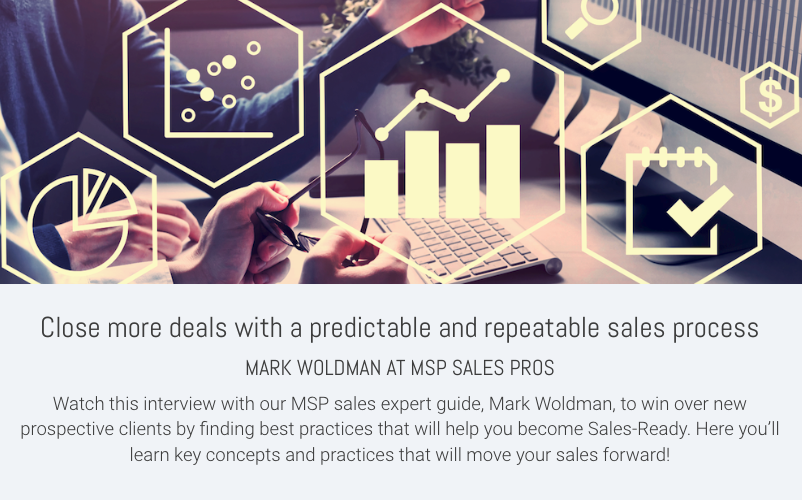
Thin Focus vs. Broad Focus
In MSP 1.0 you focus on technology, and your part of the client side. Maybe you give them quarterly planning sessions, even some kind of strategy, but the scope of these projects is limited to your service scope. In MSP 2.0 you think of the entire operation holistically from the client's perspective.
You re-think your MSP 1.0 service as one piece of the pie, and now manage all the vendors, third parties, and even the internal IT team to some extent. You negotiate the support contract for the ERP vendor, sign the bill of the telco company and so on. Your focus is on the global value creation of the IT, not just the MSP 1.0 scope.
Low Level vs. High Level
Alistair Forbes, General Manager of GFIMAX is presenting the Concept publicly first

With this in mind you can see that the MSP 1.0 focuses on technology and low level execution. MSP 2.0 focuses more on high level management. Don’t think of one as better than the other, but rather as models with different scope and approach.
Most of the time, the low level ground work isn’t visible to the C level executives. They are not able to measure and evaluate costs. In high level work, you are dealing with them personally and you help them with their problems. Your visibility is entirely more significant.
High vs. Low Acquisition Cost
With MSP 1.0 you’re often being summoned by a client with some painful problem. If they do not have IT related issues, it can be difficult to convince them to move forward. Also since other problems will keep arising at unpredictable and distinct times, you can’t stay connected with the prospect and ready when they have the next painful issue. It’s necessary to keep the relationship going for a long time in order to be visible and trusted to let them know of impending problems to which you have solutions.
The process of starting a business can be quite slow and unpredictable. On the other hand, MSP 2.0 gives a solution to a general problem, and is not dependant on big problems and imminent pains. You are able to start the conversation any time. Reframing this approach will lead to closing more deals. MSP 2.0 means you can start a basic service and as problems and opportunities arise you can upsell your higher value MSP 2.0 services.
Hard to Acquire vs. Unique Value Proposition
The other sales-related problem in MSP 1.0 is not just the closure ratio and the long cycle, but the effort needed. Usually the entry barrier is very high. If there is another MSP vendor, even a poor performer, you have to be able to prove your service is better at the same price, and usually you have to bear some part of the switchover costs. This means a fight over minimal margins.
In MSP 2.0 your service is of a higher level with a very Unique Value Proposition. It does not really matter what the existing situation is on the low level. You can offer your services in a white space, without internal competition. This makes the process easier, without sacrificing the profits, and without high switching costs. Of course still if you are competing with any MSP they will be seen as redundant quickly.
Pushy Sales vs. Consultative Sales
MSP 1.0 is a quite competitive place to be, so sales tactics can be pushy with practiced sales techniques, closing strategies, and unnatural communication. It reduces the comfort of the prospect and erodes trust, because you need to talk them into something.
Immediate solutions to real problems are still in play, but this occurs less and less as the market saturates.
In MSP 2.0 with 7C, the sales technique is different: a consultative sales approach. You get to know them in a business and IT perspective, in casual meetings with questions, helping you and them both understand their situation with a questionnaire-based benchmark and report, conduct a workshop, and create an action plan.
The more consultative experience shows your value from the get-go. It’s also more natural, as you can demonstrate your valuable expertise in a formatted way and garner trust during the sales process.
No MSP Sales Process vs. Predictable MSP Sales Funnel
Usually smaller IT managed services providers don’t have any sales oriented people, so the sales process is absent and the acquisition and the upsell unpredictable. Even more mature mid-size IT companies lack a streamlined, well-controlled, transparent sales funnel with all the metrics and motivation for the salesforce.
MSP 2.0 with 7C IT management framework is both the sales funnel and the consultative sales process. If you have a clear message for the audience, the inbound marketing is easier. You have an inbound marketing tool, a discovery tool, questionnaire, analysis, report, workshop, action plan builder and first quarterly plan.
This sales process will identify the necessary relationships, rationally spread the responsibility and clarify accountability. Also, because the process is well-defined, you are able to easily educate the client for more predictable results.
You can quickly implement the funnel as an inbound marketing campaign, and expect new clients in 4-6 weeks. Even an inside salesperson can acquire good quality, targeted prospects in 2-3 reframing workshops, which, with a 50% closure ratio is 4-6 new clients every month.
Low CEO Awareness vs. High CEO Awareness
As we have seen before, general awareness of the MSP 1.0 services is quite low. Usually during the reframing workshop with existing clients, it turns out that they don’t know what you do on a weekly or monthly basis with their back-ups, policies, and so on.
You may have discussed it with them and they may have nodded to do it, but these don’t stay front of mind, especially if you are working so well that you avoid outages or firefights, and completely disappear. In MSP 2.0 with 7C, you are working with the CEO directly.
You solve their business-related problems, gather information for them to help guide their decisions, lead their virtual IT department with all the vendors and internal IT staff, and report to the CEO directly. This greatly enhances your visibility and awareness of the CEO as to what it is you do and how much value you actually deliver. It’s a different relationship, trust, and respect level.
Slow Progress vs. Immediate Results
Although managed services providers usually have a wide portfolio of services, the client often signs up for a limited part of it, and it’s a very slow process to upsell all the great new services. Why? MSPs are not really proactive, and the whole portfolio is rarely known as part of the client’s business lexicon.
The client sees separate services instead of the big picture you can bring. With the 7C MSP 2.0 this is different. It’s much easier for the client to draw a development roadmap for 1-2 years, and execute the development plan with the MSP, because you put your and other IT services into their business context.
You are able to gradually raise the maturity of the client in a measurable, accountable journey. This gives you a faster, more aligned process to grow on the client side. Everything starts with a very solid 1st quarterly plan. Executing it flawlessly will open the door to further development projects.
Commodity vs. Margin
Alistair Forbes, General Manager of GFIMAX is presenting the Concept publicly
Because the MSP 1.0 market is now so saturated, the competition is tight, vendors deal directly with clients, and services are in very tough markets. This is called a communization, where, at the end, services are differentiated only by price.
To avoid the communization and avoid lower margins and price reductions, you have to change or extend your model. MSP 2.0 with 7C provides the client unique benefit and business context, and a very powerful weapon against their competition, leaving you in a very unique position.
This way, you are able to sell your existing offers at a higher price, while also more streamlined, and very profitable. Also, because the MSP 2.0 model is very new and rare, it’s seen as a high value service worth a higher price.
Avarage Brand vs. Remarkable Brand
As a local technology company, it can be very hard to be seen as a remarkable brand. With all the communication, service delivery, and collaterals, 100% alignment is needed to give a consistent brand feeling. You have to have a very unique value proposition where everybody knows what’s behind it. Volvo is a safe car, Starbucks is a great place to relax, Apple is a great user experience.
MSP 1.0, doesn’t include these engaging messages. MSP 2.0 with 7C, it’s different. You can show a very stable user experience during the sales process, your messages, the service delivery, and communications. It is fundamentally more professionalism and inclusive while maintaining a friendly, down-to-earth feeling. Your brand will emerge and become remarkable locally with high referral rates and powerful communication.
Cloud risk vs. Could proof
The Cloud is disrupting the MSP 1.0’s main business and revenue stream, its infrastructure projects and support. All related services are changing, as well as the consumption rates. This is hurting MSPs. In MSP 2.0 with 7C, the cloud model is actually favourable. You can use the growing complexity and business impact of the several different cloud-based applications and services to sell to the management layer on the client side.
Mixing Cloud applications with on-site integrations and reliability concerns means security is a big issue. You can control the whole ecosystem and build a solid service, managing IT at a high level and ensure departments, technologies, approaches, and models of delivering IT are completely in harmony regardless of the client’s particular business model.


